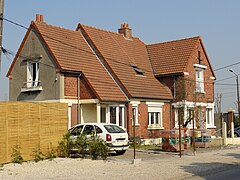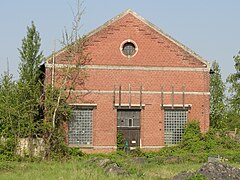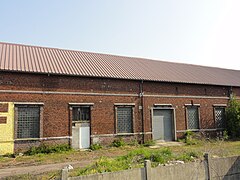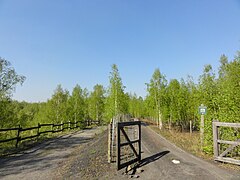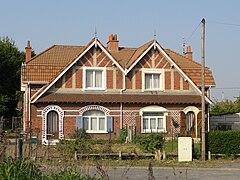Draft:Fosse Bonnel
 | Draft article not currently submitted for review.
This is a draft Articles for creation (AfC) submission. It is not currently pending review. While there are no deadlines, abandoned drafts may be deleted after six months. To edit the draft click on the "Edit" tab at the top of the window. To be accepted, a draft should:
It is strongly discouraged to write about yourself, your business or employer. If you do so, you must declare it. Where to get help
How to improve a draft
You can also browse Wikipedia:Featured articles and Wikipedia:Good articles to find examples of Wikipedia's best writing on topics similar to your proposed article. Improving your odds of a speedy review To improve your odds of a faster review, tag your draft with relevant WikiProject tags using the button below. This will let reviewers know a new draft has been submitted in their area of interest. For instance, if you wrote about a female astronomer, you would want to add the Biography, Astronomy, and Women scientists tags. Editor resources
Last edited by Significa liberdade (talk | contribs) 31 days ago. (Update) |
This article has multiple issues. Please help improve it or discuss these issues on the talk page. (Learn how and when to remove these template messages)
|
 The Bonnel Pit in 1926. | |
| Location | |
|---|---|
| Location | Lallaing |
| Region | Nord |
| Country | France |
| Production | |
| Products | Coal |
| Type | Underground |
| Owner | |
| Company | Aniche Mining Company |
The Bonnel Pit of the Aniche Mining Company is a former coal mine in the Mining Basin of Nord-Pas-de-Calais, located in Lallaing. The two shafts were started in 1913 and 1914, while the Bernard and Lemay pits were under construction in the north of the concession. The war halted the works, which were not resumed until 1921, the year in which the pit was repaired. The sinking of shaft No. 1 was completed on December 10, 1921, and the pit began production in 1923, with shaft No. 2 coming into service two years later. The Barrois Pit was commissioned in 1931, a little more than two kilometers east of the Bonnel Pit.
The Aniche Mining Company was nationalized in 1946, and became part of the Douai Group. Shaft No. 1 was deepened for concentration on the Barrois Pit, which was effective in 1964. Bonnel then provided service until 1974 and ventilation until June 30, 1984, the date on which the Barrois concentration closed. The shafts were backfilled in 1985, and the installations were destroyed the following year.
At the beginning of the 21st century, Charbonnages de France marked the heads of shafts Bonnel Nos. 1 and 2. Four buildings of the pit remain, as well as the mining towns, whether they were built before or after nationalization.
The Pit[edit]
![]() Media related to Bonnel Pit at Wikimedia Commons
Media related to Bonnel Pit at Wikimedia Commons
While the Aniche Mining Company had begun to exploit the northern part of its concession in the previous decade by opening the Déjardin and De Sessevalle pits, it opened new pits in the north of its concession in the 1910s: Bernard, Lemay, and Bonnel. These did not really start producing until after World War I.[citation needed]
Sinking[edit]
A new pit was started south of Lallaing, 2280 meters east-southeast of the Déjardin pit, and 4590 meters west-northwest of the Lemay pit.[citation needed]
The sinking of Bonnel shaft No. 1 began in 1913, with a diameter of 5.10 meters. The casing was made of cast iron from 90 centimeters to 89.20 meters deep. The coal seam was reached at 148.50 meters. Shaft No. 2 was started in 1914, 55 meters west of shaft No. 1, with a diameter of four meters, a scheme common to the Lemay pit, and to a lesser extent De Sessevalle. The casing was in cast iron from 90 centimeters to 89.32 meters deep. The coal seam was reached at 147.50 meters. Due to World War I, the sinking of shaft No. 1 was stopped on July 4, 1914, at a depth of 189 meters. The sinking of the second shaft was also suspended.[citation needed]
The pit was repaired after the war. Work on shaft No. 1 resumed on July 15, 1921, and was completed on December 10 at a depth of 300 meters. Shaft No. 2 was also resumed that year.[citation needed]
Operation[edit]
The Aniche Mining Company acquired the Flines Mining Company on January 13, 1922. Extraction began in 1923. Shaft No. 2 was put into service in 1925.[citation needed]
The Barrois Pit, started four years earlier, began producing in 1931, located 2245 meters east-southeast of the Bonnel Pit.[citation needed]
The Aniche Mining Company was nationalized in 1946, and became part of the Douai Group. The last level was then at 290 meters, but the pit was deepened for concentration on Barrois, which was effective in 1964. From that date, like the Lemay Pit from 1965, the Bonnel Pit provided ventilation and service for the concentration, while the extraction was carried out through the Barrois Pit. The service ceased in 1974, two years after the Lemay Pit. Ventilation ceased on June 30, 1984, when the Barrois concentration closed.[citation needed]
The Bonnel shafts Nos. 1 and 2, respectively 500 and 305 meters deep, were backfilled in 1985. Eight levels were established in the first shaft at 160, 199, 225, 290, 303, 358, 413, and 495 meters, while shaft No. 2 had four levels, established at 160, 198, 225, and 290 meters. The headframe of shaft Bonnel No. 1 was dynamited on April 2, 1986, and that of shaft No. 2 on April 15.[citation needed]
Conversion[edit]
At the beginning of the 21st century, Charbonnages de France marked the heads of shafts Bonnel Nos. 1 and 2. The BRGM conducts inspections there every year.[1]
-
Bonnel shaft No. 1, 1913 - 1985.
-
The marked head of shaft Bonnel No. 1.
-
The shaft in its environment.
-
Bonnel shaft No. 2, 1914 - 1985.
-
The marked head of shaft Bonnel No. 2.
-
The shaft in its environment.
The pit retains the guard's house, offices, workshop-store-boiler room, and bathhouses.[2]
-
The concierge's house.
-
The offices.
-
The workshop-store-boiler room.
-
The workshop-store-boiler room.
-
Detail of an oeil-de-boeuf.
-
The bathhouses.
The slag heaps[edit]
Like the Déjardin or Lemay pits, the Bonnel pit does not have its own slag heap.[3] The creation of the Barrois pit at the end of the 1920s led to the construction of a railway branch from the Bonnel pit, established on the cavalier slag heap No. 250,[4] known asCavalier de Bonnel to Barrois. When the Bonnel pit was concentrated on the Barrois pit, its waste was sent to the slag heaps Nos. 143[5] and 143A,[6] Germinies Sud and Germinies Nord.[3]
-
The slag heap No. 250.
-
The slag heap No. 143.
-
The slag heap No. 143.
-
The slag heap No. 143A.
-
The slag heap No. 143A.
The settlements[edit]
![]() Media related to Settlements of the Bonnel pit at Wikimedia Commons
Media related to Settlements of the Bonnel pit at Wikimedia Commons
Large settlements were built to the northwest of the pit. After nationalization, additional housing was also built, including some camus.
-
Houses grouped in pairs.
-
Houses grouped in pairs.
-
Houses grouped in fours.
-
Post-nationalization housing.
-
Post-nationalization housing.
-
A low camus.
-
A high camus, now rare in the mining basin.
Notes and references[edit]
- ^ Cite error: The named reference
Puitswas invoked but never defined (see the help page). - ^ Cite error: The named reference
R1was invoked but never defined (see the help page). - ^ a b Cite error: The named reference
Terrilswas invoked but never defined (see the help page). - ^ Cite error: The named reference
R4was invoked but never defined (see the help page). - ^ Cite error: The named reference
R2was invoked but never defined (see the help page). - ^ Cite error: The named reference
R3was invoked but never defined (see the help page).







